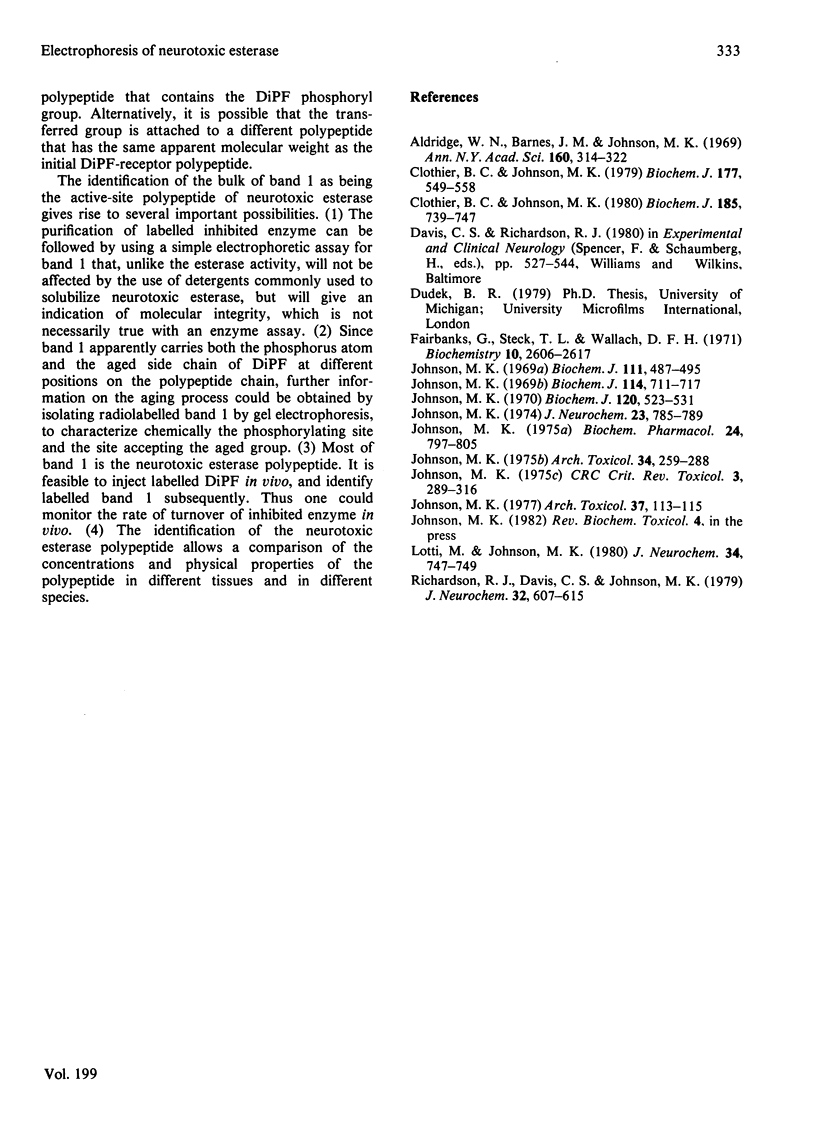Abstract
The particulate fraction from hen brain was labelled with [3H]di-isopropyl phosphorofluoridate (DiPF) and separated by polyacrylamide-gel electrophoresis. Four radioactive protein bands (1--4) of molecular weights 155000, 92000, 60000, and 30000 were resolved. Most of the labelling of bands 2, 3 and 4 was inhibited by preincubation with Paraoxon. The residue in band 4 was sensitive to pH 5.2. Successive treatments with Paraoxon and pH 5.2 resulted in the abolition of bands 3 and 4. Bands 1 and 2 contained one and two polypeptides respectively, whose labelling was sensitive to Mipafox, but one, in band 2, was sensitive to higher concentrations of Paraoxon. The concentrations of the other two polypeptides were 6.7 and 1.95 pmol of DiPF bound/g of brain in bands 1 and 2 respectively. Both were as sensitive to Mipafox as neurotoxic esterase and were also sensitive to phenyl benzylcarbamate. 4-Nitrophenyl di-n-pentylphosphinate given in vivo inhibited neurotoxic esterase and the labelling of the band-1 polypeptide by 82% and 84% respectively, but inhibited the labelling of the band 2 polypeptide by 51%. The phosphinate in vitro produced 98% inhibition of the labelling of the band-1 polypeptide, with only 26% inhibition of the band-2 polypeptide, under conditions sufficient to inhibit neurotoxic esterase totally. Both neurotoxic esterase and the band-1 polypeptide were found in the forebrain at 1.74-fold their concentration in the rest of the brain, whereas the band-2 polypeptide was uniformly distributed. The evidence indicates that the Mipafox-sensitive polypeptide in band 1 is the [3H]DiPF-labelled active-site subunit of neurotoxic esterase. The catalytic-centre activity of the enzyme for phenyl valerate hydrolysis was found to be 2.6 x 10(5) min-1.
Full text
PDF










Selected References
These references are in PubMed. This may not be the complete list of references from this article.
- Aldridge W. N., Barnes J. M., Johnson M. K. Studies on delayed neurotoxicity produced by some organophosphorus compounds. Ann N Y Acad Sci. 1969;160(1):314–322. doi: 10.1111/j.1749-6632.1969.tb15851.x. [DOI] [PubMed] [Google Scholar]
- Clothier B., Johnson M. K. Rapid aging of neurotoxic esterase after inhibition by di-isopropyl phosphorofluoridate. Biochem J. 1979 Feb 1;177(2):549–558. doi: 10.1042/bj1770549. [DOI] [PMC free article] [PubMed] [Google Scholar]
- Clothier B., Johnson M. K. Reactivation and aging of neurotoxic esterase inhibited by a variety of organophosphorus esters. Biochem J. 1980 Mar 1;185(3):739–747. doi: 10.1042/bj1850739. [DOI] [PMC free article] [PubMed] [Google Scholar]
- Fairbanks G., Steck T. L., Wallach D. F. Electrophoretic analysis of the major polypeptides of the human erythrocyte membrane. Biochemistry. 1971 Jun 22;10(13):2606–2617. doi: 10.1021/bi00789a030. [DOI] [PubMed] [Google Scholar]
- Johnson M. K. A phosphorylation site in brain and the delayed neurotoxic effect of some organophosphorus compounds. Biochem J. 1969 Feb;111(4):487–495. doi: 10.1042/bj1110487. [DOI] [PMC free article] [PubMed] [Google Scholar]
- Johnson M. K. Improved assay of neurotoxic esterase for screening organophosphates for delayed neurotoxicity potential. Arch Toxicol. 1977 Jun 18;37(2):113–115. doi: 10.1007/BF00293860. [DOI] [PubMed] [Google Scholar]
- Johnson M. K. Organophosphorus and other inhibitors of brain 'neurotoxic esterase' and the development of delayed neurotoxicity in hens. Biochem J. 1970 Dec;120(3):523–531. doi: 10.1042/bj1200523. [DOI] [PMC free article] [PubMed] [Google Scholar]
- Johnson M. K. Organophosphorus esters causing delayed neurotoxic effects: mechanism of action and structure activity studies. Arch Toxicol. 1975 Dec 18;34(4):259–288. doi: 10.1007/BF00353848. [DOI] [PubMed] [Google Scholar]
- Johnson M. K. Structure-activity relationships for substrates and inhibitors of hen brain neurotoxic esterase. Biochem Pharmacol. 1975 Apr 1;24(7):797–805. doi: 10.1016/0006-2952(75)90123-9. [DOI] [PubMed] [Google Scholar]
- Johnson M. K. The delayed neuropathy caused by some organophosphorus esters: mechanism and challenge. CRC Crit Rev Toxicol. 1975 Jun;3(3):289–316. doi: 10.3109/10408447509079861. [DOI] [PubMed] [Google Scholar]
- Johnson M. K. The delayed neurotoxic effect of some organophosphorus compounds. Identification of the phosphorylation site as an esterase. Biochem J. 1969 Oct;114(4):711–717. doi: 10.1042/bj1140711. [DOI] [PMC free article] [PubMed] [Google Scholar]
- Johnson M. K. The primary biochemical lesion leading to the delayed neurotoxic effects of some organophosphorus esters. J Neurochem. 1974 Oct;23(4):785–789. doi: 10.1111/j.1471-4159.1974.tb04404.x. [DOI] [PubMed] [Google Scholar]
- Lotti M., Johnson M. K. Neurotoxic esterase in human nervous tissue. J Neurochem. 1980 Mar;34(3):747–749. doi: 10.1111/j.1471-4159.1980.tb11208.x. [DOI] [PubMed] [Google Scholar]
- Richardson R. J., Davis C. S., Johnson M. K. Subcellular distribution of marker enzymes and of neurotoxic esterase in adult hen brain. J Neurochem. 1979 Feb;32(2):607–615. doi: 10.1111/j.1471-4159.1979.tb00391.x. [DOI] [PubMed] [Google Scholar]


